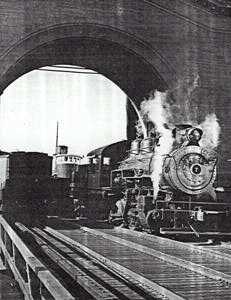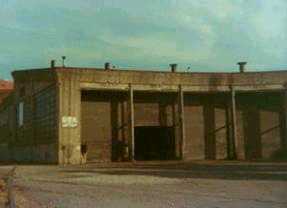![[Golden Gate Railroad Museum]](ggrmlogo.gif)
![[Golden Gate Railroad Museum]](ggrmlogo.gif)

State Belt Locomtive #7 switching at Pier 43 near Fisherman's Wharf (c. 1940)
The State Belt Railroad of California was a shortline that served San Francisco's waterfront until the 1980's. It's tracks extended the length of the Embarcadero from south of Market Street to Fort Mason and the Presidio. Although locals nicknamed the line the Toonerville Trolley and the Wooden Axle Line, the State Belt had an illustrious career.
The first trackage of the State Belt was built by the Board of State Harbor Commissioners in 1889. At that time, the lands along waterfront were owned by the State, not San Francisco. These lands were once under water, so they were not included in the original survey of the City.
The original tracks were dual-gauged, to allow transfer of narrow gauge freight cars from the North Pacific Coast R.R. (Marin County) and the South Pacific Coast R.R. (Alameda, Santa Clara, Santa Cruz counties), as well as standard gauge cars. These first tracks did not yet connect to the outside world - all cars were ferried in from around the San Francisco Bay. Belt tracks finally connected with Southern Pacific tracks in 1913 at a small interchange yard located at Townsend and Berry Streets.

The Roundhouse at Sansome and Embarcadero (c. 1978)
The State Belt built a five-stall concrete-reinforced roundhouse at Sansome and the Embarcadero. (This historic structure still stands today as an office building). This engine facility housed a modest number of oil-fired steam switchers (mostly 0-6-0's), and later, ALCO S-2 diesels. The railroad also owned four freight cars - idler flatcars that were used to prevent the heavy engines from rolling onto the car ferries.
State Belt's ferry slips were located near Fisherman's Wharf. The railroad transferred cars from the Santa Fe, the Northwestern Pacific, and the Western Pacific. In the twenties, the Santa Fe built its own car ferry operation in China Basin, and State Belt tracks were extended over Third Street and the Mission Creek drawbridge to make a connection.

Fort Mason Tunnel East Portal and Trestle in 1913
Construction at the 1915 Panama-Pacific World's Fair and traffic to Fort Mason justified the construction of a tunnel, 1500 feet long, 15 feet wide and 22 feet high underneath the Fort Mason Military Reservation. Eventually tracks were extended across what is now the Marina District to Crissy Field to serve the Presidio.
World War II generated a large amount of trans-Pacific traffic, and the State Belt contributed greatly to the movement of materials during the War. Army and Navy switchers were added to provide enough locomotive capacity. The State Belt also delivered trainloads of fresh troops to debarkation points, and picked up hospital trains and returning troops. The railroad moved 156 troop trains and 265 hospital trains in 1945 alone.
Operations slowly wound down as shipping moved across the Bay to Oakland. In 1969, with the State wanting to get out of the port business, San Francisco voters approved a bond issue to buy the Port of San Francisco. The State Belt R.R. thus became the San Francisco Belt Railroad. Later in 1973, the City offered to sell the railroad to any operator for $1. After more than half a year, a 20-year contract to operate the railroad was signed with Kyle Railways. Total trackage had fallen from 67 miles in 1950 to 58 miles in 1973.
The end of the railroad came in 1993. By then, most trackage north of the Ferry building was gone or inactive. The only activity took place at Pier 96, a newly built container facility near Hunter's Point. ALCO S-2 #23 was chosen to serve the facility, complete with the new number 49 and a new paint job in 49er colors. Engine #49, along with #25 are now on long term loan to the Museum from the Port of San Francisco. They join State Belt Steam Engine #4 as part of the GGRM's San Francisco Railroading Heritage collection.
Text by Thomas Beutel
The following sources have good information about the State Belt Railroad.
This is an early history of the railroad. It includes a Steam Engine roster and photos of #1, #3, #10, and #20.
Article discusses closing of the San Francisco Belt Line R.R. on Jan. 29, 1993. Also presents brief history and a 1906 photo looking east from Vallejo Street.
This is the best history of the railroad that we've found. It has many pictures and it also includes a table of locomotive statistics and builders numbers.
Contains descriptions of construction and maintenance, financials, pictures of Fort Mason tunnel, picture of engine house, picture of locomotive #7, and complete 1914 map of system trackage from Fourth Street to Laguna Street.
Contains a general history of the railroad, along with pictures and a suggestion of how to build a model of the railroad.
The museum has a collection of photographs of State Belt locomotives (nos. 1 (original), 1 (new), 6, 8, 9, 10, 11, 20, 21, 22, 23, 24, and 25). Some photographs also show various work scenes and maintenance of way cars.
To My Train Yard
To My HOME page